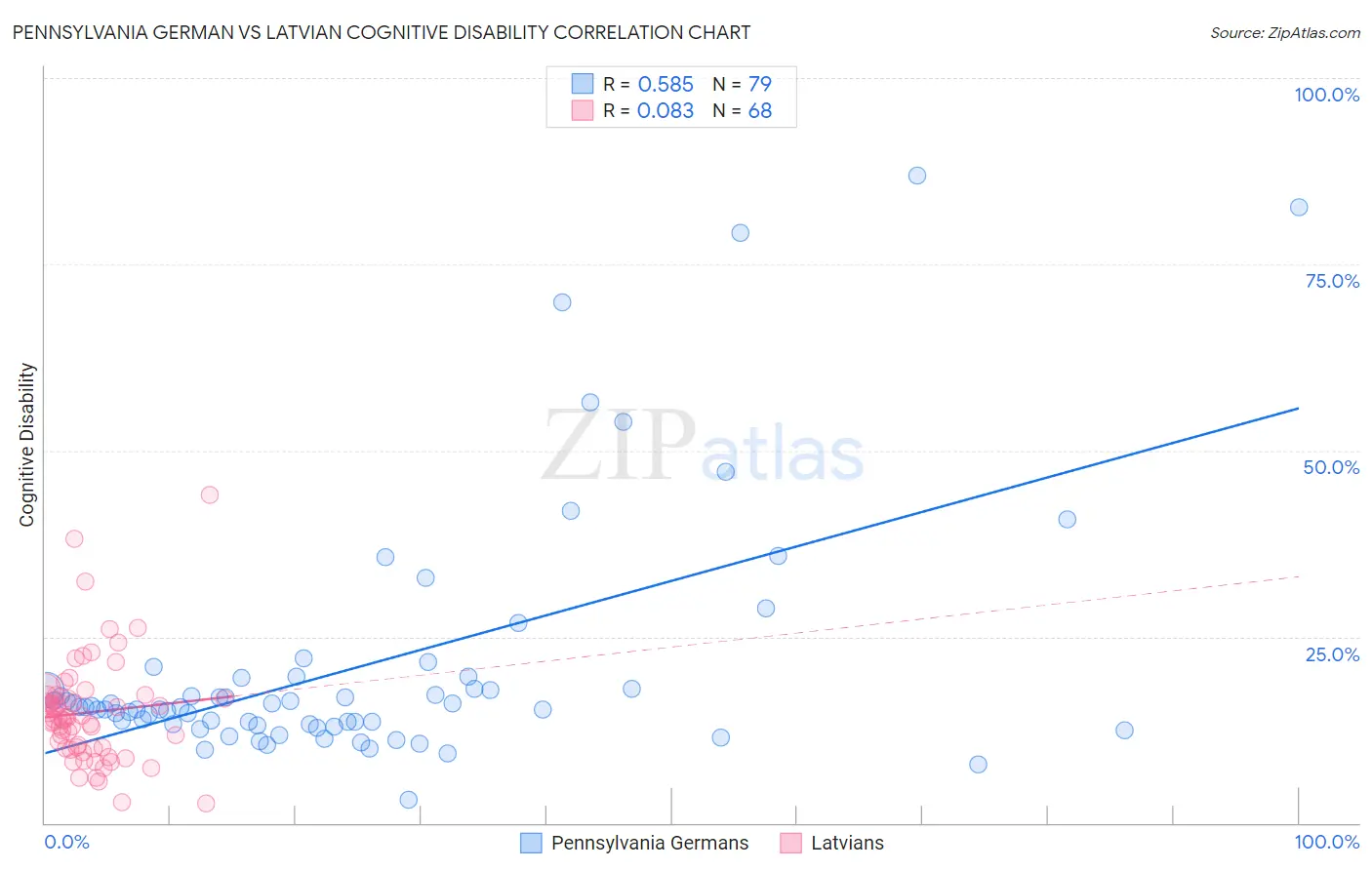Pennsylvania German vs Latvian Cognitive Disability
COMPARE
Pennsylvania German
Latvian
Cognitive Disability
Cognitive Disability Comparison
Pennsylvania Germans
Latvians
16.6%
COGNITIVE DISABILITY
99.7/ 100
METRIC RATING
58th/ 347
METRIC RANK
16.6%
COGNITIVE DISABILITY
99.5/ 100
METRIC RATING
67th/ 347
METRIC RANK
Pennsylvania German vs Latvian Cognitive Disability Correlation Chart
The statistical analysis conducted on geographies consisting of 234,106,123 people shows a substantial positive correlation between the proportion of Pennsylvania Germans and percentage of population with cognitive disability in the United States with a correlation coefficient (R) of 0.585 and weighted average of 16.6%. Similarly, the statistical analysis conducted on geographies consisting of 220,719,023 people shows a slight positive correlation between the proportion of Latvians and percentage of population with cognitive disability in the United States with a correlation coefficient (R) of 0.083 and weighted average of 16.6%, a difference of 0.36%.

Cognitive Disability Correlation Summary
| Measurement | Pennsylvania German | Latvian |
| Minimum | 3.1% | 2.6% |
| Maximum | 87.0% | 44.0% |
| Range | 83.8% | 41.5% |
| Mean | 21.1% | 14.8% |
| Median | 15.5% | 14.0% |
| Interquartile 25% (IQ1) | 13.2% | 10.1% |
| Interquartile 75% (IQ3) | 19.5% | 16.8% |
| Interquartile Range (IQR) | 6.3% | 6.7% |
| Standard Deviation (Sample) | 16.7% | 7.2% |
| Standard Deviation (Population) | 16.6% | 7.2% |
Demographics Similar to Pennsylvania Germans and Latvians by Cognitive Disability
In terms of cognitive disability, the demographic groups most similar to Pennsylvania Germans are Immigrants from Peru (16.6%, a difference of 0.0%), Romanian (16.6%, a difference of 0.010%), Immigrants from England (16.6%, a difference of 0.070%), Austrian (16.6%, a difference of 0.080%), and Bhutanese (16.6%, a difference of 0.080%). Similarly, the demographic groups most similar to Latvians are Immigrants from Ukraine (16.6%, a difference of 0.040%), Ukrainian (16.6%, a difference of 0.040%), Immigrants from Uzbekistan (16.7%, a difference of 0.12%), Immigrants from Sweden (16.7%, a difference of 0.13%), and Immigrants from Belgium (16.7%, a difference of 0.14%).
| Demographics | Rating | Rank | Cognitive Disability |
| Soviet Union | 99.8 /100 | #52 | Exceptional 16.5% |
| Swedes | 99.8 /100 | #53 | Exceptional 16.5% |
| Immigrants | Iran | 99.8 /100 | #54 | Exceptional 16.5% |
| Immigrants | Venezuela | 99.7 /100 | #55 | Exceptional 16.5% |
| Austrians | 99.7 /100 | #56 | Exceptional 16.6% |
| Bhutanese | 99.7 /100 | #57 | Exceptional 16.6% |
| Pennsylvania Germans | 99.7 /100 | #58 | Exceptional 16.6% |
| Immigrants | Peru | 99.7 /100 | #59 | Exceptional 16.6% |
| Romanians | 99.7 /100 | #60 | Exceptional 16.6% |
| Immigrants | England | 99.6 /100 | #61 | Exceptional 16.6% |
| Czechoslovakians | 99.6 /100 | #62 | Exceptional 16.6% |
| Argentineans | 99.6 /100 | #63 | Exceptional 16.6% |
| Venezuelans | 99.6 /100 | #64 | Exceptional 16.6% |
| Colombians | 99.6 /100 | #65 | Exceptional 16.6% |
| Immigrants | Ukraine | 99.5 /100 | #66 | Exceptional 16.6% |
| Latvians | 99.5 /100 | #67 | Exceptional 16.6% |
| Ukrainians | 99.4 /100 | #68 | Exceptional 16.6% |
| Immigrants | Uzbekistan | 99.4 /100 | #69 | Exceptional 16.7% |
| Immigrants | Sweden | 99.4 /100 | #70 | Exceptional 16.7% |
| Immigrants | Belgium | 99.3 /100 | #71 | Exceptional 16.7% |
| Germans | 99.3 /100 | #72 | Exceptional 16.7% |